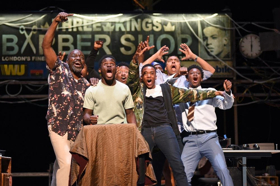Review: BARBER SHOP CHRONICLES: Conversations and Coiffures

Barber Shop Chronicles
Written by Inua Ellams, Directed by Bijan Sheibani; Designer, Rae Smith; Lighting Designer, Jack Knowles; Movement Director, Aline David; Sound Designer, Gareth Fry; Music Director, Michael Henry; Fight Director, Kev McCurdy; Associate Director, Stella Odunlami, Leian John-Baptiste; Assistant Choreographer, Kwami Odoom; Barber Consultant, Peter Atakpo; Company Voice Work, Charmian Hoare; Dialect Coach, Hazel Holder; Tour Casting Director, Lotte Hines; Company Stage Manager, Julia Reid; A.R.T. Production Stage Manager, Taylor Brennan
CAST (in alphabetical order): Tuwaine Barrett, Elliot Edusah, Maynard Eziashi, Alhaji Fofana, Solomon Israel, Mohammed Mansaray, Patrice Naiambana, Anthony Ofoegbu, Kenneth Omole, Ekow Quartey, Jo Servi, David Webber
Performances through January 5; Co-production by Fuel, National Theatre, and West Yorkshire Playhouse, presented by American Repertory Theater at Loeb Drama Center, 64 Brattle Street, Cambridge, MA; Box Office 617-547-8300 or www.americanrepertorytheater.org
Barber Shop Chronicles takes you on a cultural exchange trip without you ever having to leave your seat at the Loeb Drama Center. As part of its US premiere tour, the American Repertory Theater hosts the show in co-production with London's Fuel, National Theatre, and West Yorkshire Playhouse. Nigerian-British playwright Inua Ellams hopscotched across Africa, with a side journey to the UK, to immerse himself in the communities manifested in barber shops, soak up the local flavor, and discover the universality of the experience. An ensemble of a dozen men, all making their A.R.T. debuts, re-enacts the quotidian routines of the tonsorial parlors and shares the stories of the barbers and their assorted denizens.
Ellams' play is about the conversations that take place in the barber shop, focusing on the relationships the men have with each other, with their fathers and sons, and the women in their lives. However, two other key areas of interest drive much of the dialogue and ratchet up the emotional temperature: soccer (futbol) and politics. Considering the amount of talking that goes on, Barber Shop Chronicles never feels static or dull. Divided into 14 scenes that travel back and forth between shops in England, South Africa, Zimbabwe, Uganda, Nigeria, and Ghana, Director Bijan Sheibani crafts staging that is kinetic, with the actors dancing and singing, even while moving set pieces around, during scene changes (Music Director, Michael Henry; Movement Director, Aline David).
Each of the scenes is a slice of life that can stand on its own, more or less, but there is a deeper through-story in Three Kings, the London shop that is revisited several times. There is tension between young Samuel (Elliot Edusah) and older Emmanuel (Anthony Ofoegbu) relating to ownership of the shop, sometimes placing the third barber, Winston (Solomon Israel), in the middle in the position of peacemaker. As the travelogue jumps to other locales, the characters are not always easily discernible (most of the actors are double- or triple-cast), but all 30 of them are well-drawn and played with brio by the rest of the ensemble: Tuwaine Barrett, Maynard Eziashi, Alhaji Fofana, Mohammed Mansaray, Patrice Naiambana, Kenneth Omole, Ekow Quartey, Jo Servi, and David Webber.
Designer Rae Smith orients the audience to the country in question with a series of colorful banners and signs naming the shops, each lit in turn (lighting designer, Jack Knowles), and sound designer Gareth Fry highlights the musical interludes and captures the play-by-play of soccer matches on radio or television. Regardless of where the action takes place, the similarities in the stories and conversations are greater than the differences, and it is abundantly clear that the men consider the barber shop to be a safe haven where they are free to be themselves and speak their minds. (While women may also feel connected and at home in their hair salons, it is not their routine gathering place, and is less a cultural phenomenon than it is for men.)
Ellams admits to eavesdropping in the barber shops he visited and transcribing the local stories. He captures the distinct personalities and flavors represented in each scene, conveying a range of emotions and the camaraderie among the men. Unfortunately, the diversity of dialects and accents makes it very challenging to catch everything that is said, and it might behoove someone with little knowledge about the politics of African nations to do a bit of homework ahead of time. However, the language gap notwithstanding, Barber Shop Chronicles underscores the value and importance of language, endorses the belief that words matter, and ties it all up with joyful song and dance.
Photo credit: Tim Trumble (The Ensemble of Barber Shop Chronicles)
Reader Reviews
Videos

